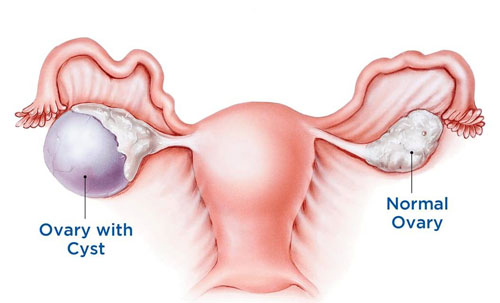Ovarian cyst
Ovarian cysts are fluid-filled sacs in the ovary. They are common and usually form during ovulation. Ovulation happens when the ovary releases an egg each month. Many women with ovarian cysts don’t have symptoms. The cysts are usually harmless.
Types of Ovarian Cysts:
The most common types of ovarian cysts (called functional cysts) form during the menstrual cycle. They are usually benign (not cancerous).
The two most common types of cysts are:

Follicle cysts:
In a normal menstrual cycle, an ovary releases an egg each month. The egg grows inside a tiny sac called a follicle. When the egg matures, the follicle breaks open to release the egg. Follicle cysts form when the follicle doesn’t break open to release the egg. This causes the follicle to continue growing into a cyst. Follicle cysts often have no symptoms and go away in one to three months.
Corpus luteum cysts
Once the follicle breaks open and releases the egg, the empty follicle sac shrinks into a mass of cells called corpus luteum. Corpus luteum makes hormones to prepare for the next egg for the next menstrual cycle. Corpus luteum cysts form if the sac doesn’t shrink. Instead, the sac reseals itself after the egg is released, and then fluid builds up inside. Most corpus luteumcysts go away after a few weeks. But, they can grow to almost four inches wide. They also may bleed or twist the ovary and cause pain. Some medicines used to cause ovulation can raise the risk of getting these cysts.
Other types of benign ovarian cysts are less common:
Endometriomas are caused by endometriosis. Endometriosis happens when the lining of the uterus (womb) grows outside of the uterus.
In some women, the ovaries make many small cysts. This is called polycystic ovary syndrome (PCOS). PCOS can cause problems with the ovaries and with getting pregnant.
Malignant (cancerous) cysts are rare. They are more common in older women. Cancerous cysts are ovarian cancer. For this reason, ovarian cysts should be checked by your doctor. Most ovarian cysts are not cancerous.
Symptoms:
Most ovarian cysts are small and don’t cause symptoms.
If a cyst does cause symptoms, you may have pressure, bloating, swelling, or pain in the lower abdomen on the side of the cyst. This pain may be sharp or dull and may come and go.
If a cyst ruptures, it can cause sudden, severe pain.
If a cyst causes twisting of an ovary, you may have pain along with nausea and vomiting.
Other symptoms of an ovarian cyst can include:
Pain in the lower back or thighs
Trouble emptying your bladder completely
Pain during sex
Weight gain
Pain during your period
Breast tenderness
Abnormal vaginal bleeding (rare)
Cause of Ovarian Cysts:
Most common causes of ovarian cysts include –
Hormonal Problems
Endometriosis
Pregnancy
Severe pelvic infections
Polycystic ovarian syndrome (PCOS)
Prevalence:
Worldwide, about 7% of women have an ovarian cyst at some point in their lives. In Europe, a large screening trial revealed a 21.2% incidence of ovarian cysts among healthy postmenopausal women.
Diagnosis:
As most ovarian cysts cause no symptoms, many cysts are diagnosed by chance – for example, during a routine examination, or if you have an ultrasound scan for another reason.
Pelvic ultrasound – If you have symptoms suggestive of an ovarian cyst, your doctor may examine your abdomen and perform an internal (vaginal) examination. Your doctor may be able to feel an abnormal swelling which may be a cyst.
Laparoscopy – Using a laparoscope — a slim, lighted instrument inserted into your abdomen through a small incision — your doctor can see your ovaries and remove the ovarian cyst. This is a surgical procedure that requires anaesthesia.
CA 125 blood test – Blood levels of a protein called cancer antigen 125 (CA 125) often are elevated in women with ovarian cancer. If your cyst is partially solid and you’re at high risk of ovarian cancer, your doctor might order this test.
Elevated CA 125 levels can also occur in noncancerous conditions, such as endometriosis, uterine fibroids and pelvic inflammatory disease.
Some women may have other tests – for example, a computerised tomography (CT) scan or a magnetic resonance imaging (MRI) scan. For the most common type of benign ovarian cysts this is not needed. It may be useful when the ultrasound scan is not conclusive and/or the CA125 result is higher than normal.
Treatment:
Treatment of ovarian cysts depends on patient’s age, the type and size of cyst and symptoms. Your doctor might suggest:
Observation – Many small ovarian cysts will resolve and disappear over a few months. You may be advised to have a repeat ultrasound scan after a few months or so. If the cyst goes away then no further action is needed.
Medication:
Your doctor might recommend hormonal contraceptives, such as birth control pills, to keep ovarian cysts from recurring. However, birth control pills won’t shrink an existing cyst.
Surgery – Removal of an ovarian cyst may be advised, especially if you have symptoms or if the cyst is large. Sometimes the specialist may want to remove it to determine exactly which type of cyst it is and to make sure there are no cancer cells in it.
Most smaller cysts can be removed by laparoscopic surgery. Some cysts require a more open style of operation, with a cut in the lower part of the tummy.
Ovarian cystectomy – Some cysts can be removed without removing the ovary.
Oophorectomy – In some cases, your doctor might suggest removing the affected ovary and leaving the other intact.
Total Hysterectomy – If a cystic mass is cancerous, you might need to have your uterus; ovaries and fallopian tubes removed and undergo chemotherapy or radiation.
Doctors recommend surgery when an ovarian cyst develops after menopause.
